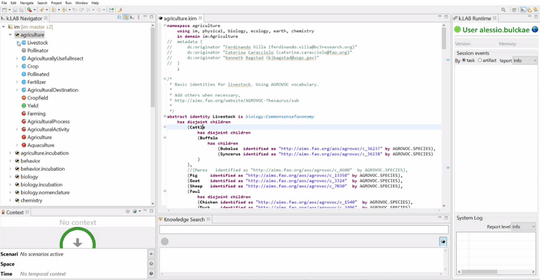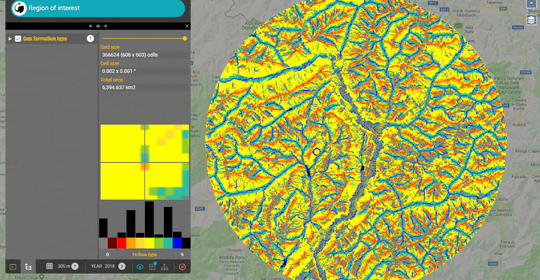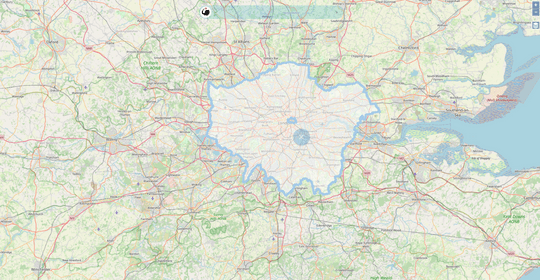Technology for 21st century science
delivered by a comprehensive, open-source software stackAI-powered knowledge integration
ARIES is powered by cutting-edge integrated modeling technology in development since 2007, which can be accessed online.
The technology and corresponding k.LAB software are not specific to ecosystem services (i.e., they can be applied to other integrated modeling problems) and will be documented for developers and users at our future sister site dedicated to general integrated modeling.
The innovations we introduced with k.LAB are fully operational, and we have been teaching their principles and use at ARIES training events since 2013.
ARIES can be applied in numerous ways:
- As a modeler, you can build on others’ work by connecting to the k.LAB network, providing automated access to a growing library of interoperable data and models shared by others. The semantics specified using the k.IM language ensures that the information available on the network has exactly the same meaning to the original developers as for you. You can use specialized, open-source software to access the network and develop new models, and you can install a k.LAB networked engine to deploy your models as services and make them available to others in your institution through the network.
- As an institution, you can maximize investment in reusable data and model components by installing a k.LAB network node, where you can publish research outputs in forms that make them available, with full access control, to partner organizations or the general public. All the knowledge you develop becomes part of a network where the best models and data will eventually be selected and rewarded by usage, just like web pages do on the Internet.
- As a researcher, you can develop models and annotate your data in the k.IM language, which integrates existing data and models and allows creation of new ones. The language completely describes each dataset or model’s semantics, allowing it to exist independently on a network node, and to be used and reused based solely on the meaning of its associated semantics. In other words, k.LAB enables new levels of modularity and interoperability between independently developed data and models, which has been a holy grail of the modeling community for decades.
- As a decision maker, you will soon be able to connect to modeling engines through the k.EXPLORER, an interface that enables a two-step modeling workflow (set a context and observe a concept). With minimal training and videoturorials, running many sophisticated models will become a simple matter of searching and observing a concept over a context – a user workflow that closely resembles the familiar ways we use the Internet today.


ARIES’ development
We have developed a prototype k.LAB software package for ARIES modelers and a second-stage prototype for ARIES models’ end users called k.EXPLORER. We aim to make the software as ‘user-friendly’ as possible through intuitive GUI- and web-based interfaces.
The first ARIES prototype was released into the public domain in 2008, providing an open-source, web-based technology offered to users worldwide to assist rapid ecosystem service assessment and valuation.
The second-stage ARIES prototype is due for release alongside the K.LAB prototype within the next year. This interface does not have a public prototype yet; it will implement the two-step workflow using a familiar web search interface, only requiring a drag-and-drop action of a selected concept to automatically generate model outputs.
The latest prototypes are released at each year’s International Spring University on Ecosystem Service Modelling.


k.LAB is a knowledge laboratory
k.LAB is a software platform designed to integrate models via the use of well-defined scientific concepts. The software gives access to an integrated network of web-accessible models, cataloged and related across scientific disciplines through semantics. k.LAB provides a user-friendly means to query the network, seeking information about a concept of interest. The system links natural science (e.g., process-based models) and human behavior (e.g., agent-based models) effortlessly and resolves differences in units or scale automatically, enabling outputs to support complex, interdisciplinary decisions. Behind the scenes, an artificially intelligent engine assembles the best possible workflow to compute outputs that describe the concept of interest to the modeler or decision maker.
This deductive process builds a decision tree to resolve the principal concept to the most suitable data or model and in turn resolves any other concepts required by the data or models chosen at each step, seamlessly linking models to provide holistic outputs that support real-world decision making. Specific, detailed models are chosen over more general, coarser alternatives as long as data exist to support them. To properly match models to contexts, k.LAB uses a sophisticated, multiple criteria ranking algorithm that can mix objective criteria (such as spatio-temporal resolution or currency) with user-provided rankings of data or model reliability and quality. The most visible application of k.LAB has been the ARIES project, a suite of state-of-the-art ecosystem services models aimed at supporting science-based decision-making. ARIES, while young, stands out as the first real-world tool for social-environmental systems modeling, using knowledge and models built independently by many actors and endorsed by the scientific community to produce holistic outputs, making evidence-based environmental decision making easier and more effective.
Changing how we understand and use data and models
Concept-based (or more technically, semantically driven) approaches have been discussed as a strategy to improve current modelling practices for decades. However, no approach has yet shown enough results to emerge as an accepted standard, making the k.LAB prototype a first real opportunity to reach this stage. k.LAB’s integrated modelling paradigm is ideal for use on the “cloud,” and allows users to query the existing knowledge base and independently contribute data and models that can be shared and linked automatically for other users. This creates a potentially Wikipedia-like archive of community sourced models that grows in value to the scientific community with increasing use.
Secure certificates enable us to permit access to certain network-available models to different user groups, allowing very easy access to scientific data and models. The provision of integrative data and models has applicability to numerous fields (e.g., evaluation of disease transmission, commercial modelling of customer behaviors, or financial analysis of the resilience of loan applicants in the face of economic shocks). The diverse uses of k.LAB have not been fully explored.